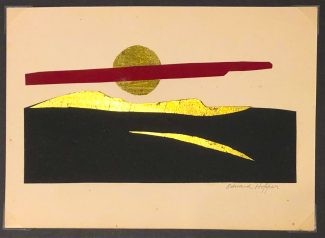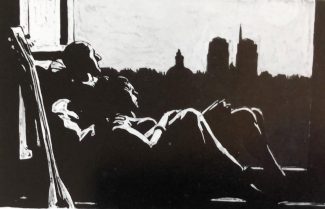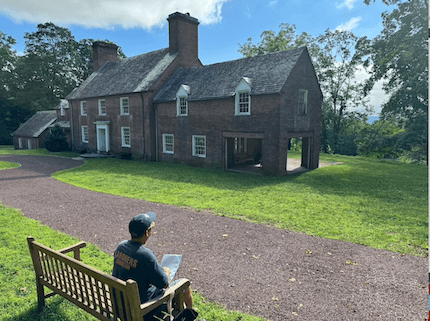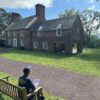Hopper’s Christmas Spirit on Display at the Edward Hopper House Museum & Study Center
 Biographies of the late Edward Hopper, as well as the man’s paintings themselves, give the impression that the Nyack-born artist was more Scrooge than Bob Cratchit–not particularly friendly or fond of anyone (including Jo if we are to believe things written in her journal). But Edward Hopper actually made his own Christmas cards and Christmas gift tags, a sampling of which are on display this month at the Edward Hopper House Museum & Study Center. The exhibition is curated by Carole Perry, former Museum Director, and she notes that they show another side of Hopper–that he was a reserved man with great affection for family and friends, who exhibited a wry, quiet sense of humor.
Biographies of the late Edward Hopper, as well as the man’s paintings themselves, give the impression that the Nyack-born artist was more Scrooge than Bob Cratchit–not particularly friendly or fond of anyone (including Jo if we are to believe things written in her journal). But Edward Hopper actually made his own Christmas cards and Christmas gift tags, a sampling of which are on display this month at the Edward Hopper House Museum & Study Center. The exhibition is curated by Carole Perry, former Museum Director, and she notes that they show another side of Hopper–that he was a reserved man with great affection for family and friends, who exhibited a wry, quiet sense of humor.

Edward Hopper House Christmas card and other Hopper Christmas ephemera
Short history of Christmas Cards
The Internet generation may not fully understand how popular Christmas cards sent through the mail have been over time. The first Christmas card is thought to have been printed and sent in England in 1843 to replace personal notes. The convenience and novelty of cards quickly spread. America imported cards until they were first printed here in 1875, seven years before Hopper was born. By 1900, millions were sent each year. Families arranged cards they received on mantels, hung them around built-in wooden cabinets, or on any prominent place in the family home.
Hopper’s boyhood Christmas
Little has been written about Hopper’s early Christmases. He was drawing at age five, and he received a blackboard for Christmas when he was ten. He made cutout soldiers (a collage technique later used in his Christmas cards) and pasted them to his paint box.

Edward Hopper sketch of a snowball fight 1892-95 from the Whitney Museum of American Art
Surely, young Eddie Hopper saw and received cards as the popularity of cards soared in Victorian America. But other questions remain: Did Edward’s father, Garret Hopper, sell cards in his dry goods store at 6 S. Broadway (now Grace’s Thrift Shop) where Edward helped out? Did Edward study cards at Dutcher’s Stationery shop just a few doors from his dad’s store where he bought art supplies?
In his early drawings that date back to age ten, there are no Christmas trees, Santas, sleds, gifts, and only one wintry scene of a snowball fight. (There are two early oils of the iced-over Nyack Skating Pond and a snowy Nyack Baptist Church.) Hopper’s mature paintings are anything but sentimental; infused with dramatic, stark slanting light rather than a Renoiresque, gauzy, snowy light.
Hopper’s first Christmas card
 It comes as a mild shock to see Hopper’s first Christmas card* to Jo Nivison in 1923, before they were married in July 1924. The scene is classic Hopper with natural light defining two individuals in a room in front of a window. But the warmth of two individuals embracing is very uncharacteristic. The lute at the left of the sketch, and the view of the Notre Dame cathedral towers in the distance, add to the scene’s romance. To complete the effect, Hopper writes in French, the couple’s private language. The quote is from a Paul Verlaine poem written for his fiancé:
It comes as a mild shock to see Hopper’s first Christmas card* to Jo Nivison in 1923, before they were married in July 1924. The scene is classic Hopper with natural light defining two individuals in a room in front of a window. But the warmth of two individuals embracing is very uncharacteristic. The lute at the left of the sketch, and the view of the Notre Dame cathedral towers in the distance, add to the scene’s romance. To complete the effect, Hopper writes in French, the couple’s private language. The quote is from a Paul Verlaine poem written for his fiancé:
A huge and gentle
Peacefulness
Seems to come
From the heaven
That the moon illumines:
It is the exquisite hour.
–Paul Verlaine, La Bonne Chanson, trans. John Van Sickle
Christmas Cards
Not much is known about Hopper’s Matisse-like cutout Christmas cards.** We don’t know if he made them every year, whether he handmade a small number of cards, nor how many of the cards still exist. The Edward Hopper House & Museum has several examples of his cards. Each card-sized work was a collage of colored paper, signed by the artist.
Two examples evoke scenes he painted near his summer home in Truro, Massachusetts. South Church in Truro was painted in 1930 shortly after the Hoppers first came to Truro, so it is possible that the card dates to that time. On the back of the card, Jo writes a cheery note that, “this is a fine old church of South Truro. E.H. has made a fine canvas of it.” The stark modern design uses colored paper for the moon, church, and churchyard. A second card evokes Hopper’s watercolor of Truro’s Highland Light (although Hopper painted many New England Lighthouses in his career). In this work he uses a strong black silhouette of the Highland Light coupled with a gold band of paper radiating from the tower.
 Also on display at the Hopper House is an interesting card, various versions of which have been sold online. Once again the format is a collage of colored paper that repeats the planet motif used in other cards. A horizontal cloud crosses in front of the planet (in the museum’s copy, the color is deep red; in others online, it is silver). Beneath is a two-color landscape of rolling hills. One version offered online for sale attributes the date as 1930, another displays a note on the back of the framed piece stating that it was sent to friends in 1957 evoking the painting Western Motel, 1957, perhaps because of the representational hills seen through the motel window. It is likely given the similarity to other cards that the date is much earlier.
Also on display at the Hopper House is an interesting card, various versions of which have been sold online. Once again the format is a collage of colored paper that repeats the planet motif used in other cards. A horizontal cloud crosses in front of the planet (in the museum’s copy, the color is deep red; in others online, it is silver). Beneath is a two-color landscape of rolling hills. One version offered online for sale attributes the date as 1930, another displays a note on the back of the framed piece stating that it was sent to friends in 1957 evoking the painting Western Motel, 1957, perhaps because of the representational hills seen through the motel window. It is likely given the similarity to other cards that the date is much earlier.In her diary, Jo mentions the 1930 Christmas card: “a lovely mosaic of colored papers” depicting St. George and the Dragon; one with “lovely silver paws all spread out—the dragons canceled each other.” In her diary, Jo also mentions Edward’s 1954 card of a choir boy with his neck raised in song. She mentions that in cards Edward wrote to his doctor and Lloyd Goodrich, he would add: “Peace on Earth, goodwill to men–& To Hell with Women.” Now that’s the stuff of the Edward Hopper we hear about.
Christmas cartoons and gift tags at the Hopper House

Christmas greetings to Hpper’s sister, Marion, 1949
Carole Perry has also included a number of gift tags, including “Eddie,” “Josie,” “Lizzie” (Hopper’s mother), and “Marion” (Hopper’s sister), in the current exhibit. Josie was always fond of cats, and in her gift tag, Hopper has placed a cutout of cat on the Nivison (Jo’s maiden name) coat of arms. As Perry stated, the gift tags were Hopper’s way of showing warmth and affection for his family, warmth that he had a hard time communicating in any other way. In a sketch filled with warmth and humor dated December 12, 1949, Hopper addressed a card to his sister, Marion, with the inscription, “I am glad you are warm at last. Enclosed is a small Christmas gift.” He signed it “Ed.” The sketch may be of Josie (note the presence of the cat) and Ed dressed as Santa crouched over a floor grate. Their Washington Square apartment in New York City was heated by a single coal heater until 1960 and was an extremely cold place in winter.
Say hello and happy holidays to a different view of Nyack’s own Edward Hopper, America’s most important 20th century painter.
Photos Credits: Mike Hays with the Courtesy of the Edward Hopper Museum & Study Center and the Whitney Museum of American Art
*Hopper’s first card to Jo is discussed in detail by Gail Levin, Edward Hopper: An Intimate Biography, 1995
**The Whitney Museum has a file of Hopper Christmas card collages
Michael Hays is a 30-year resident of the Nyacks. He grew up the son of a professor and nurse in Champaign, Illinois. He has recently retired from a long career in educational publishing with Prentice-Hall and McGraw-Hill. Hays is an avid cyclist, amateur historian and photographer, gardener, and dog walker. He has enjoyed more years than he cares to count with his beautiful companion, Bernie Richey. You can follow him on Instagram as UpperNyackMike.

 Nyack People & Places, a weekly series that features photos and profiles of citizens and scenes near Nyack, NY, is brought to you by HRHCare and Weld Realty.
Nyack People & Places, a weekly series that features photos and profiles of citizens and scenes near Nyack, NY, is brought to you by HRHCare and Weld Realty.













